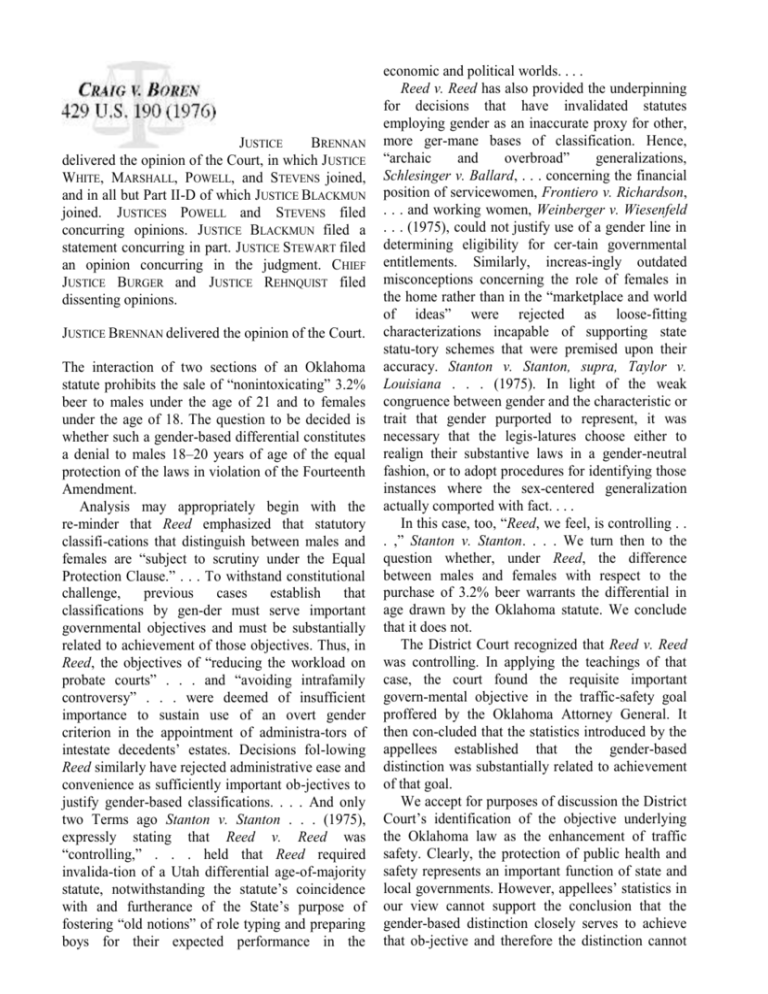Craig_v._Boren.qxd
advertisement

JUSTICE BRENNAN delivered the opinion of the Court, in which J USTICE WHITE, MARSHALL, POWELL, and STEVENS joined, and in all but Part II-D of which JUSTICE BLACKMUN joined. JUSTICES POWELL and STEVENS filed concurring opinions. JUSTICE BLACKMUN filed a statement concurring in part. JUSTICE STEWART filed an opinion concurring in the judgment. CHIEF JUSTICE BURGER and JUSTICE REHNQUIST filed dissenting opinions. JUSTICE BRENNAN delivered the opinion of the Court. The interaction of two sections of an Oklahoma statute prohibits the sale of “nonintoxicating” 3.2% beer to males under the age of 21 and to females under the age of 18. The question to be decided is whether such a gender-based differential constitutes a denial to males 18–20 years of age of the equal protection of the laws in violation of the Fourteenth Amendment. Analysis may appropriately begin with the re-minder that Reed emphasized that statutory classifi-cations that distinguish between males and females are “subject to scrutiny under the Equal Protection Clause.” . . . To withstand constitutional challenge, previous cases establish that classifications by gen-der must serve important governmental objectives and must be substantially related to achievement of those objectives. Thus, in Reed, the objectives of “reducing the workload on probate courts” . . . and “avoiding intrafamily controversy” . . . were deemed of insufficient importance to sustain use of an overt gender criterion in the appointment of administra-tors of intestate decedents’ estates. Decisions fol-lowing Reed similarly have rejected administrative ease and convenience as sufficiently important ob-jectives to justify gender-based classifications. . . . And only two Terms ago Stanton v. Stanton . . . (1975), expressly stating that Reed v. Reed was “controlling,” . . . held that Reed required invalida-tion of a Utah differential age-of-majority statute, notwithstanding the statute’s coincidence with and furtherance of the State’s purpose of fostering “old notions” of role typing and preparing boys for their expected performance in the economic and political worlds. . . . Reed v. Reed has also provided the underpinning for decisions that have invalidated statutes employing gender as an inaccurate proxy for other, more ger-mane bases of classification. Hence, “archaic and overbroad” generalizations, Schlesinger v. Ballard, . . . concerning the financial position of servicewomen, Frontiero v. Richardson, . . . and working women, Weinberger v. Wiesenfeld . . . (1975), could not justify use of a gender line in determining eligibility for cer-tain governmental entitlements. Similarly, increas-ingly outdated misconceptions concerning the role of females in the home rather than in the “marketplace and world of ideas” were rejected as loose-fitting characterizations incapable of supporting state statu-tory schemes that were premised upon their accuracy. Stanton v. Stanton, supra, Taylor v. Louisiana . . . (1975). In light of the weak congruence between gender and the characteristic or trait that gender purported to represent, it was necessary that the legis-latures choose either to realign their substantive laws in a gender-neutral fashion, or to adopt procedures for identifying those instances where the sex-centered generalization actually comported with fact. . . . In this case, too, “Reed, we feel, is controlling . . . ,” Stanton v. Stanton. . . . We turn then to the question whether, under Reed, the difference between males and females with respect to the purchase of 3.2% beer warrants the differential in age drawn by the Oklahoma statute. We conclude that it does not. The District Court recognized that Reed v. Reed was controlling. In applying the teachings of that case, the court found the requisite important govern-mental objective in the traffic-safety goal proffered by the Oklahoma Attorney General. It then con-cluded that the statistics introduced by the appellees established that the gender-based distinction was substantially related to achievement of that goal. We accept for purposes of discussion the District Court’s identification of the objective underlying the Oklahoma law as the enhancement of traffic safety. Clearly, the protection of public health and safety represents an important function of state and local governments. However, appellees’ statistics in our view cannot support the conclusion that the gender-based distinction closely serves to achieve that ob-jective and therefore the distinction cannot under Reed withstand equal protection challenge. Moreover, the statistics exhibit a variety of other shortcomings that seriously impugn their value to equal protection analysis. Setting aside the obvious methodological problems, the surveys do not adequately justify the salient features of Oklahoma’s gender-based traffic-safety law. None purports to measure the use and dangerousness of 3.2% beer as opposed to alcohol generally, a detail that is of particular importance since, in light of its low alcohol level, Oklahoma apparently considers the 3.2% beverage to be “nonintoxicating.” . . . Moreover, many of the studies, while graphically documenting the unfortunate increase in driving while under the influence of alcohol, make no ef-fort to relate their findings to age-sex differentials as involved here. Indeed, the only survey that ex-plicitly centered its attention upon young drivers and their use of beer—albeit apparently not of the diluted 3.2% variety—reached results that hardly can be viewed as impressive in justifying either a gender or age classification. There is no reason to belabor this line of analy-sis. It is unrealistic to expect either members of the judiciary or state officials to be well versed in the rigors of experimental or statistical technique. But this merely illustrates that proving broad sociologi-cal propositions by statistics is a dubious business, and one that inevitably is in tension with the nor-mative philosophy that underlies the Equal Protection Clause. Suffice to say that the showing offered by the appellees does not satisfy us that sex represents a legitimate, accurate proxy for the regu-lation of drinking and driving. In fact, when it is further recognized that Oklahoma’s statute pro-hibits only the selling of 3.2% beer to young males and not their drinking the beverage once acquired (even after purchase by their 18–20-year-old fe-male companions), the relationship between gender and traffic safety becomes far too tenuous to satisfy Reed’s requirement that the gender-based differ-ence be substantially related to achievement of the statutory objective. We hold, therefore, that under Reed, Oklahoma’s 3.2% beer statute invidiously discriminates against males 18–20 years of age. [The concurring opinions of JUSTICES POWELL, STEVENS, BLACKMUN, and STEWART are not reprinted here.] CHIEF JUSTICE BURGER, dissenting: I am in general agreement with JUSTICE REHNQUIST’s dissent, but even at the risk of compounding the ob-vious confusion created by those voting to reverse the District Court, I will add a few words. Of the merits, we have only recently recognized that our duty is not “to create substantive constitu-tional rights in the name of guaranteeing equal protection of the laws.” San Antonio School Dist. v. Rodriguez . . . (1973). Thus, even interests of such im-portance in our society as public education and hous-ing do not qualify as “fundamental rights” for equal protection purposes because they have no textually in-dependent constitutional status. . . . Though today’s decision does not go so far as to make gender-based classifications “suspect,” it makes gender a disfavored classification. Without an independent constitutional basis supporting the right asserted or disfavoring the classification adopted, I can justify no substantive constitutional protection other than the normal . . . protection afforded by the Equal Protection Clause. The means employed by the Oklahoma Legislature to achieve the objectives sought may not be agreeable to some judges, but since eight Members of the Court think the means not irrational, I see no basis for strik-ing down the statute as violative of the Constitution simply because we find it unwise, unneeded, or possi-bly even a bit foolish. JUSTICE REHNQUIST, dissenting: The Court’s disposition of this case is objectionable on two grounds. First is its conclusion that men chal-lenging a gender-based statute which treats them less favorably than women may invoke a more stringent standard of judicial review than pertains to most other types of classifications. Second is the Court’s enunciation of this standard, without citation to any source, as being that “classifications by gender must serve important governmental objectives and must be substantially related to achievement of those ob-jectives.” Ante, at 197 (emphasis added). The only redeeming feature of the Court’s opinion, to my mind, is that it apparently signals a retreat by those who joined the plurality opinion in Frontiero v. Richardson . . . (1973) from their view that sex is a Craig v. Boren “suspect” classification for purposes of equal protec-tion analysis. I think the Oklahoma statute chal-lenged here need pass only the “rational basis” equal protection analysis expounded in cases such as McGowan v. Maryland . . . (1961), and I believe that it is constitutional under that analysis. them. And even if we manage to avoid both confu-sion and the mirroring of our own preferences in the development of this new doctrine, the thousands of judges in other courts who must interpret the Equal Protection Clause may not be so fortunate. . . . ... The Court’s conclusion that a law which treats males less favorably than females “must serve im-portant governmental objectives and must be substantially related to achievement of those objec-tives” apparently comes out of thin air. The Equal Protection Clause contains no such language, and none of our previous cases adopt that standard. I would think we have had enough difficulty with the two standards of review which our cases have rec-ognized—the norm of “rational basis,” and the “compelling state interest” required where a “suspect classification” is involved—so as to counsel weight-ily against the insertion of still another “standard” be-tween those two. How is this court to divine what ob-jectives are important? How is it to determine whether a particular law is “substantially” related to the achievement of such objective, rather than related in some other way to its achievement? Both of the phrases used are so diaphanous and elastic as to invite subjective judicial preferences or prejudices relating to particular types of legislation, masquerading as judgments whether such legislation is directed at “important” objectives or, whether the relationship to those objectives is “substantial” enough. I would have thought that if this Court were to leave anything to decision by the popularly elected branches of the Government, where no constitutional claim other than that of equal protection is invoked, it would be the decision as to what governmental ob-jectives to be achieved by law are “important,” and which are not. As for the second part of the Court’s new test, the Judicial Branch is probably in no worse position than the Legislative or Executive Branches to determine if there is any rational relationship be-tween a classification and the purpose which it might be thought to serve. But the introduction of the ad-verb “substantially” requires courts to make subjec-tive judgments as to operational effects, for which neither their expertise nor their access to data fits Craig v. Boren







